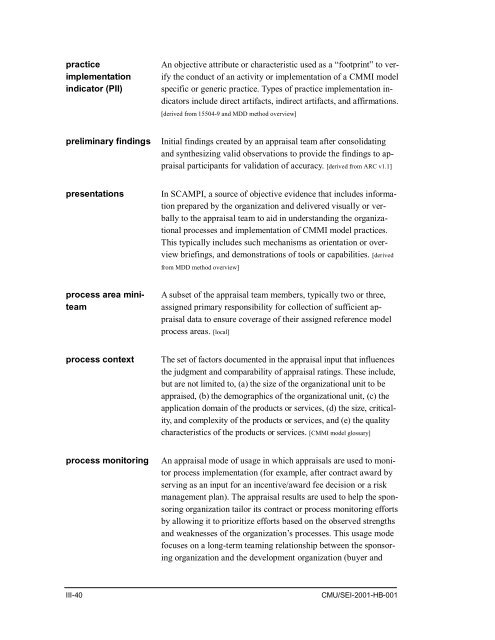Standard CMMI Appraisal Method for Process Improvement (SCAMPI)
Standard CMMI Appraisal Method for Process Improvement (SCAMPI)
Standard CMMI Appraisal Method for Process Improvement (SCAMPI)
Create successful ePaper yourself
Turn your PDF publications into a flip-book with our unique Google optimized e-Paper software.
practice<br />
implementation<br />
indicator (PII)<br />
An objective attribute or characteristic used as a “footprint” to verify<br />
the conduct of an activity or implementation of a <strong>CMMI</strong> model<br />
specific or generic practice. Types of practice implementation indicators<br />
include direct artifacts, indirect artifacts, and affirmations.<br />
[derived from 15504-9 and MDD method overview]<br />
preliminary findings<br />
Initial findings created by an appraisal team after consolidating<br />
and synthesizing valid observations to provide the findings to appraisal<br />
participants <strong>for</strong> validation of accuracy. [derived from ARC v1.1]<br />
presentations<br />
In <strong>SCAMPI</strong>, a source of objective evidence that includes in<strong>for</strong>mation<br />
prepared by the organization and delivered visually or verbally<br />
to the appraisal team to aid in understanding the organizational<br />
processes and implementation of <strong>CMMI</strong> model practices.<br />
This typically includes such mechanisms as orientation or overview<br />
briefings, and demonstrations of tools or capabilities. [derived<br />
from MDD method overview]<br />
process area miniteam<br />
A subset of the appraisal team members, typically two or three,<br />
assigned primary responsibility <strong>for</strong> collection of sufficient appraisal<br />
data to ensure coverage of their assigned reference model<br />
process areas. [local]<br />
process context<br />
The set of factors documented in the appraisal input that influences<br />
the judgment and comparability of appraisal ratings. These include,<br />
but are not limited to, (a) the size of the organizational unit to be<br />
appraised, (b) the demographics of the organizational unit, (c) the<br />
application domain of the products or services, (d) the size, criticality,<br />
and complexity of the products or services, and (e) the quality<br />
characteristics of the products or services. [<strong>CMMI</strong> model glossary]<br />
process monitoring<br />
An appraisal mode of usage in which appraisals are used to monitor<br />
process implementation (<strong>for</strong> example, after contract award by<br />
serving as an input <strong>for</strong> an incentive/award fee decision or a risk<br />
management plan). The appraisal results are used to help the sponsoring<br />
organization tailor its contract or process monitoring ef<strong>for</strong>ts<br />
by allowing it to prioritize ef<strong>for</strong>ts based on the observed strengths<br />
and weaknesses of the organization’s processes. This usage mode<br />
focuses on a long-term teaming relationship between the sponsoring<br />
organization and the development organization (buyer and<br />
III-40<br />
CMU/SEI-2001-HB-001
















